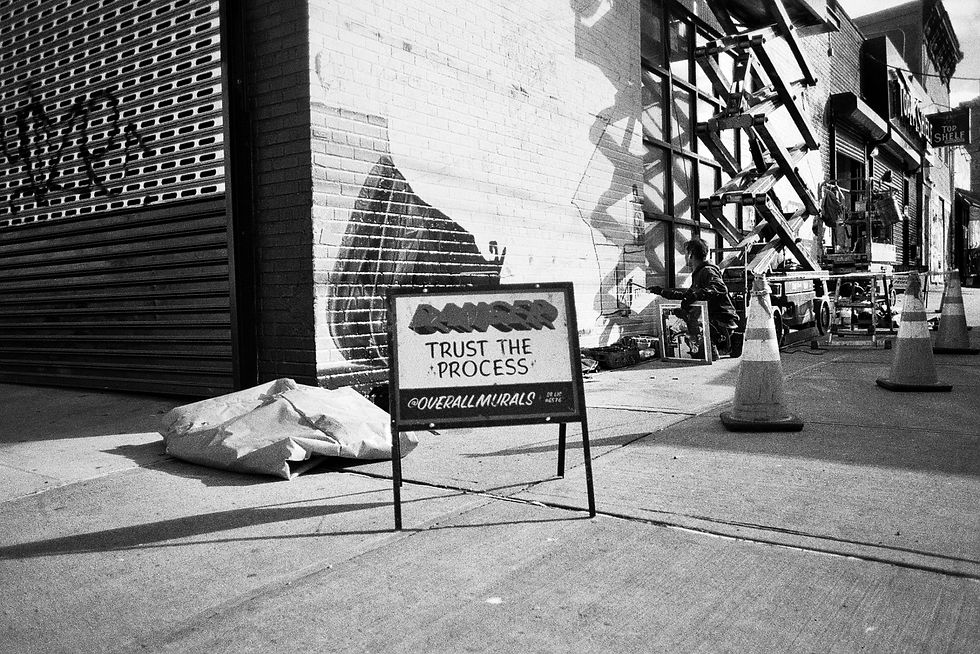apprenticeship workshop
- Anna Golden-Dukes
- Mar 20, 2023
- 4 min read
Updated: Aug 30, 2023
A Day In the life
It's 6:00 AM.
You roll out of bed, rub the gunk out of your eyes and quickly look for yesterday's pants. Smell your t-shirt, hope it doesn't smell too much like yesterday's paint, get ready for the long day outside, and walk out the door.
You look for a place to sit on the train. You get lucky. You put your headphones in and escape the 45-minute commute before you find yourself in the heart of SoHo. Then, up the stairs into New York streets, there you are.

A mural painter, more specifically, a walldog.
And there they are. Your paint crew, in front of a large wallscape in matching paint-covered clothes. You all have one mission, to recreate the 20 x 10 artwork in your hands into a 1,000 sq foot hand painted mural.
You have 4-5 days.
This is what it takes to be a walldog at Overall Murals.

Remember when your teachers would drill into our heads, "Practice makes perfect." Well, we hate to admit it, but those teachers were right.
We can only grow as a company if we improve our skill set. We need to pause and reflect on where we are to set intentions on where we want to go.
The same applies to our painters.
As the New Year rolled in, we (and as many of us do) set goals for ourselves.
What are your goals for this year? We'll go first!
One of our primary goals is to take our entry-level mural artists and sign painters to the next level through our 2-year Apprenticeship program.
We want to leverage the knowledge and wisdom of our most experienced painters and veteran walldogs and implement a process that improves our apprentice's techniques to become successful muralists.
When we break down the initial fundamentals of a successful walldog, the most common ones are lettering, graphic application, and managing different blends.
Our senior staff worked alongside our production team, where they created a weeklong crash course on teaching and reviewing those fundamentals, starting with our lettering course.
LETTERING
We formalized a lettering workshop to help our apprentices better understand how to best paint straight lines, smooth circles, and lettering forms in general. They learned the paints consistency and how to apply it with the right paint brush to different wall textures to achieve the desired effect of clean brush strokes.

There are a variety of typefaces that can determine what kind of brush our painters will use and their technique.
For example, the tiny text at the bottom of advertisements we tend to ignore is mandatories. The text is so small that it requires a single-stroke approach with the tiniest brush. In our workshop, we outlined the little things like this to prepare each painter for different typeface scenarios on the wall.
There are many, many, many levels to our lettering workshop. People can spend years just mastering lettering, and we want to invest in our newer painters so in time, they can be masters of their craft.
Blending
Our painters took a one-day crash course in blending, where they learned about textured blends, vertical blends, and radial blends. You're probably thinking, why all the different options? Well, the product's shape in the artwork can determine which blend achieves the most realistic effect.

For example, the blends in a cell phone ad use a linear blend, while a Coca-Cola can use a cylindrical or sphere blend. There are levels to how complex blends can achieve the desired effect.
We worked with our painters to orient themselves with a target outcome and provided fundamental techniques to blend so that they knew how to accomplish their goals when we took them to practice in the field.
RIGGING
Our painters endured a full-day workshop where they learned how to rig a wall. They understood how to create a good plan for rigging, taking into account a variety of variables.
They started with a zoomed-out point of view of the whole process and broke down each step before we took each painter through each step a few times.
Each painter learned how to pull up gear safely, tie a knot, and assemble a rig. At the end of the class, all the painters attempted the block and tackle rig system, a considerable feat when there are no motors involved, just weights rope and the strength of each individual pulling themselves and the platform they are standing on to reach the murals facade.
"It's not just painting a wall." One of our senior painters explained, "There's a whole pre-production before we can even get to the wall and begin painting. So it's essential to get everyone on our team involved in the WHOLE process to Truly appreciate our work.
And this is true!
The week-long course load developed a level of comfort and camaraderie among our painters. They learned every stage of the process and became comfortable with it before they got to the wall.

Through this process, we learned that everyone has a different level of painting experience, teaching methods, and leadership styles. This brings us to our next goal...
Sourcing feedback from everyone involved so we can evolve the curriculum and our teachers, leaders, and painters can perform at their highest level.
As we keep the tradition of hand painted outdoor advertising alive, we hope you have a better understanding of the work that goes into hand painting each mural. That way, when you see us hanging from a building ten stories up, you can say,
















































